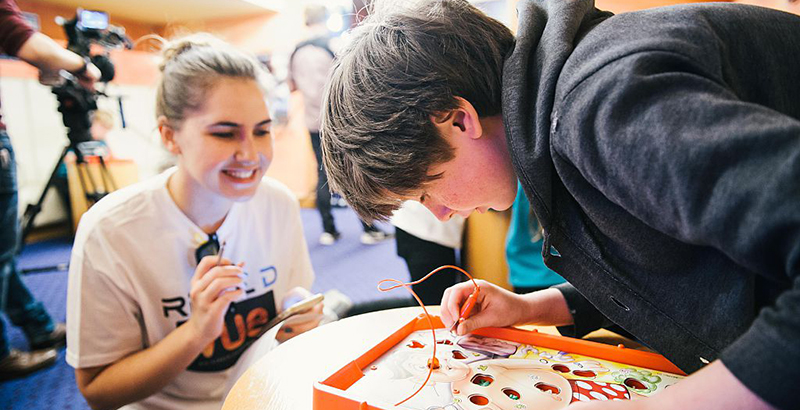Analysis: 5 Ways Adults Can Develop Children With Strong Social and Emotional Skills

“I’m a math teacher, not a counselor. I’m here to teach math,” one teacher recently told a principal I was working with in an after-school program.
The principal recounted this story while reflecting on an effort to infuse more social-emotional learning into her school.
The concept of having to “add one more thing” to overburdened teachers is nothing new. To overcome this resistance, the education field must not view SEL as a separate curriculum but instead as what it is at its core: a set of skills, competencies, and principles that inform and guide how to interact with students. That is, rather than SEL being what educators teach, it is how they teach.
A recent survey of nearly 900 principals, commissioned by the Collaborative for Academic, Social, and Emotional Learning, found that 98 percent believe that social and emotional skills should be taught to all students. This reflects school leaders’ understanding of the importance of SEL as part of the foundation for students’ success in school and throughout their lives. It also reported that 60 percent of principals believe teachers lack the training necessary to support students’ SEL needs.
Research shows that SEL improves student outcomes in both the near and long terms. A study led by SEL experts Joseph A. Durlak and Roger P. Weissberg shows that when students develop social and emotional skills, they are more likely to graduate from high school, attain a college degree, and have improved mental and physical health. According to the Yale Center for Emotional Intelligence, students who develop social and emotional skills like responsible decision-making, empathy, and the ability to identify and navigate their emotions show improved academic performance and classroom behavior.
To embed SEL into the everyday interactions between school-based adults and students, school and district leaders must commit to investing more in professional learning opportunities. With professional development that is rooted in SEL, all school staff, from classroom teachers and paraprofessionals to office administrators and bus drivers, can develop their own inherent social and emotional skills that will allow them to better model and teach these competencies to students. With a deeper understanding that learning is social and emotional, teachers can better educate the whole child by seamlessly integrating SEL into both content-based instruction and the broader culture of their school.
Many strong, supportive educators already incorporate SEL into their teaching style, perhaps without even realizing it — and often because they already know that skills like empathy, self-awareness, and responsible decision-making are important for students to succeed in school and in life. I’ve seen teachers encourage students to focus inward and ignore distractions during a spelling test to help them develop their own self-management. I’ve seen educators use emotion words when helping a frustrated student work through a difficult math problem. Dedicated training and supports can give all teachers and school staff the tools to be more intentional about infusing SEL into every interaction with students.
The rewards of a schoolwide focus on SEL extend beyond the individual student. Research shows that teachers with strong social and emotional skills develop more positive relationships with their students and are more effective at classroom management. The best part is that this support is welcome: 82 percent of teachers expressed a desire to receive SEL training.
Investing in and implementing a new professional development program can be a daunting task, and school and district leaders have many factors to consider when making such a decision, particularly around time and money spent. Here are the steps that districts and school leaders should take to create a system that supports SEL for teachers and students:
- Prioritize and allocate funding to support SEL professional learning opportunities. This not only supports the integration of SEL into the curriculum but also helps educators manage stress.
- Invest in a training program specifically focused on helping educators develop their own social and emotional skills. For example, my organization, WINGS for Kids, has partnered with Pomona Unified School District in California to provide extensive SEL training to after-school professionals throughout the district.
- View classroom and teacher observations from an SEL perspective. Create a rubric or questions on how an educator is modeling SEL and how he or she supports student development of social and emotional skills.
- Encourage teachers, administrators, and staff to reflect on their interactions with students and how they might further incorporate SEL into their work. Consider questions such as “In what ways do I talk with students, rather than to students?”
- Supplement professional development and training opportunities by sharing books about SEL and leading discussions with staff. Recommendations include The Triple Focus: A New Approach to Education by Daniel Goleman and Peter Senge and Connection Culture: The Competitive Advantage of Shared Identity, Empathy, and Understanding at Work by Michael Lee Stallard.
The proven impact of SEL on both students and teachers makes clear the benefits of investing in adults for SEL. If we truly want students with strong social and emotional skills, we must start with adults.
Bridget Laird is CEO of WINGS, a national nonprofit that teaches social-emotional skills to elementary-age students.
Get stories like these delivered straight to your inbox. Sign up for The 74 Newsletter

;)